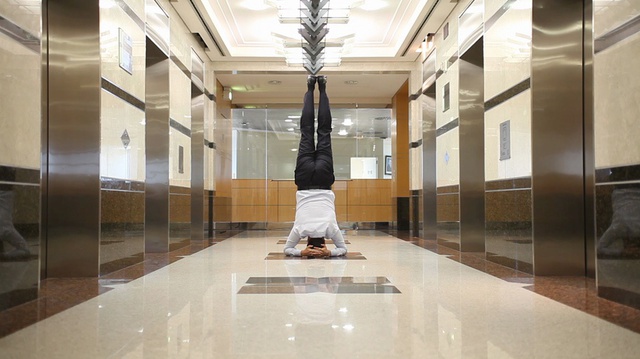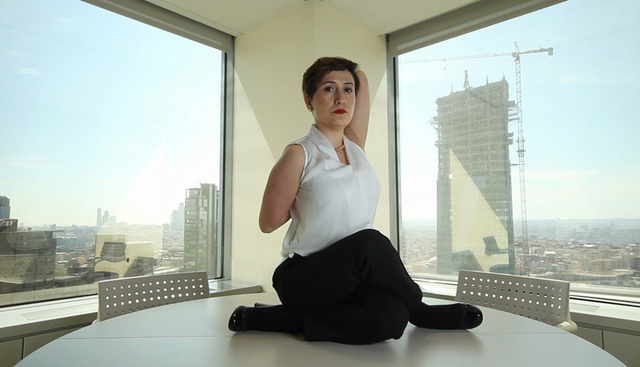Reviews
Freedom has no script
Burak Delier at Iniva
What happens after we take Gezi Park or Tahrir Square or Wall Street? "Nobody knows exactly how we will become free…" start the programme notes for Freedom has no script, the first UK exhibition by Turkish artist Burak Delier. His work examines the relationships we have with the structures of capitalism, placing particular focus on the processes of negotiation between the individual, the social value they place on themselves, and, hence, their role as it is effected within these societal structures.
The display of recent work was comprised of a sculpture and sound installation, two video-based mixed media installations, and two films, one of which is a commission, the first from Iniva’s new Commissions and Exhibitions Fund, established last year. Commenting on the Delier’s award of the commission, Tessa Jackson, Iniva’s Chief Executive said, ‘It is important artists are given the freedom to question society…Burak Delier is not only commenting on the Turkish situation, but an economic system upon which so many of our societies are based.' The commissioned film, Songs of the Possessed (2014) is the most abstract of the works in this show, and perhaps the least effective because of it. Separate from the rest of the exhibition, in Iniva’s second floor screening room, the film centres on a group of office workers, split into groups of two or three, who, at various turns, display a range of emotions to one another: at one moment screaming in frustration, at another being comfortingly sympathetic. The camera either cuts between the small groups in static close up, or twirls dizzyingly around the group as a whole.
The camerawork lends a delightfully playful quality to a staid, overly choreographed scene. Taking its cue from, notably, Fassbinder’s use of the camera technique in films including Martha (1974) and Chinese Roulette (1976), Delier uses the camera to enhance moments of intimacy between people. Runa Islam similarly examined the potency of this technique in her 1998 four-screen film installation Tuin. Used here it gives the scene a striking and bold aesthetic but adds little to an unadventurous key proposition.
The other single-screen film projection, Crisis and Control (2013), is a series of interviews undertaken with workers while they perform yoga positions in their offices in full work dress. Their responses revolve around notions of power in the workplace. A male worker insists his colleagues understand that when he is strict with them it is merely a professional tactic and not part of any personal grievance. A younger female worker explains how she plans to remove herself from her current position in the corporate structure to start her own business.
Mostly, the interviewees look straight ahead, avoiding the camera directly, answering questions either in-scene or in voiceover. Their bodies and voices strain and tremble the longer they are forced to hold their yoga stance. One interviewee sits comfortably on a desk, her hand clasped behind her back, her legs entwined around her. She bears an uncanny resemblance to Marc Quinn’s Fourth Plinth commission Alison Lapper Pregnant (2005). More than any other respondent, she looks relaxed. She looks deep into the camera and describes how, in order to be successful in her large organization; she has found that the worker must develop a personality that reflects the traits of the corporation they work for. However, in doing so the worker will lose a vital aspect of their humanity and will inevitably become merely functional, a satellite of the corporation. Though a hardly revelatory insight, with Crisis and Control, more so than Songs of the Possessed, we are introduced here to the person within the social structure. Crisis and Control introduces character and shades of emotion – it is a more incisive examination and is therefore a more responsive work than Songs of the Possessed, which feels reductive in comparison.
In Collector’s Wish (2012), Delier adopts a simple conceit: he will allow himself to receive a commission from a collector, Saruhan Doğan, but the work he creates will be of entirely the collector’s decision. Doğan commissions Delier to create a work based on a story called The Painter is Right, taken from Safahat by Mehmet Âkif Ersoy.
The story tells of a painter who convinces a man that an eighteen-foot wall painted entirely red is a depiction of Moses having parted the Red Sea. Delier quizzes Doğan about the work that is to be made, both in referential terms (what the story means to the collector), and in practical (what tone of red does Doğan imagine the wall painted, for example).
Alongside this work, The Deal (2013), a mixed media installation, depicts the contract and visual representations of a sum of money that the artist has deposited with a trader for a period of twenty days. The capital is the artwork and comes with a set of stipulations: that the trader must invest the capital for twenty full days; that if the sum increases in value after that time the trader can take ownership of the increased sum; if the capital investment decreases in value, then the sum reverts back to the artist.
These two works display their own methodological processes. They provide a fitting counterpoint to the film works. The films reference global capitalist infrastructures, while the installations are anchored on the specific roles that make up these infrastructures. These works very clearly explicate how we determine our value in the global market and how this imprecise valuation effects how we negotiate our responsibilities, i.e. our functions in work. Collector’s Wish and The Deal are demonstrations the artist’s research processes. If the exhibition has a function it is to explore the relationship between capitalism and art – these works do just that, and we are reliant on Delier, placing himself centre-stage, to act as the prism through which this examination takes place.
Delier also exhibits here a series of short video diaries, filmed on the streets on his mobile phone. He talks directly to camera about a variety of subjects. One topic is how he always presumed that it would be his artwork that would guide his direction in the art world, but this is a fallacy. Instead, he feels he should have worked more on developing personal relationships with curators, how he should have stayed longer at private views and after-parties. He talks about how it is important that an artist use Facebook aggressively, because an online presence speaks more about the artist’s personality than the work could, at a glance – another example where Delier points to the importance of understanding the artist’s intention, therefore their methodological working processes.
The diaries provide a neat conclusion to the themes of the show. They provide an insight into Delier’s distrust of social structures, but their necessity in enabling one to understand one’s position based on the value of their work. In order to prosper, he argues, there are certain social obligations that must be attended to.
These videos are displayed on a tablet-sized screen which is housed on a wall in a box with a peephole at one end and a set of headphones wired in at the other. The box is low, at chest height for the average person. As you bend forward for twenty minutes, one eye to the peephole, you may begin to wonder about your own relationship to the institution. How will your behaviour be moderated?. The most effective works in this show are a demonstration of process; they don’t necessarily require any curatorial contextualisation; Delier speaks directly to us. In this mould, global economics seems only like a proxy to begin a discussion around systems that are politically organised, from the work environment, to the stock market, to Facebook, to the art market and gallery sector itself.
Freedom has no script by Burak Delier was on exhibition at Iniva, London, between 26 March – 17 May 2014.







